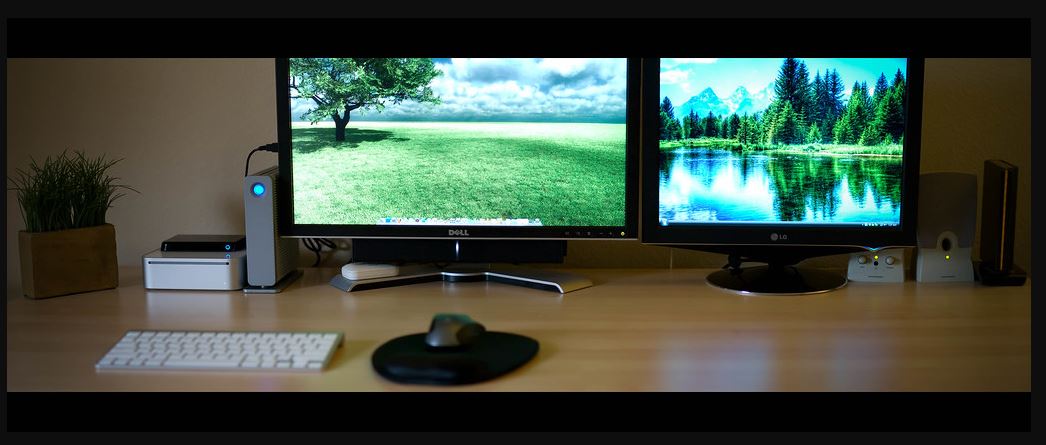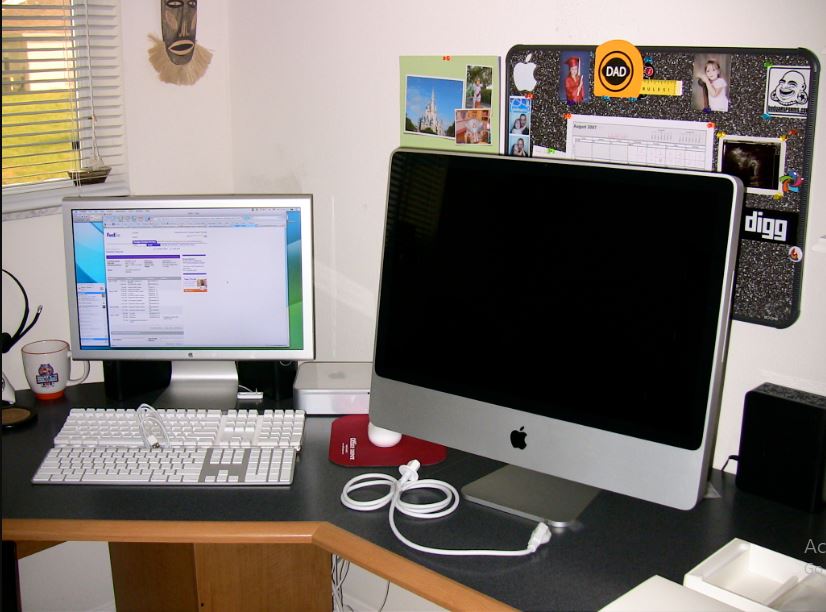In the ever-growing tech landscape, newer and bigger seem to be the order of the day. This growth is now one of the most crucial decisions facing computer users, especially with monitors. There are different screen sizes ranging from compact to colossal, and oftentimes, we find ourselves wondering. 24 vs. 27-inches monitor: Which works better?
Which monitor is better depends on your needs and preferences, but a 27-inch monitor offers more screen space. This space is great for multitasking. While a 24-inch monitor is smaller and more space-saving. It is also suitable for smaller desks and a tight budget. You have to consider your specific case and workspace while deciding which is better for you.
Both 24 and 27-inch monitors have their advantages and disadvantages and are suited for different tasks. This article will delve into the world of monitors and compare which is a better fit for your specific needs.

How Is Monitor Size Measured?
Monitor screens are always measured diagonally from one corner to the opposite corner. This measurement is known as the screen size and is always expressed in inches. The screen size represents the distance across the visible area of the screen.
The measurement helps you understand the exact physical size of the monitor before you purchase it. It is important that you get the right monitor for your task, as it can affect your visibility.
Does Monitor Size Matter In Display Quality?
Monitor size does matter in terms of display quality, but it is not the only factor to consider. There are other factors to consider, like the resolution. The resolution depends on the number of pixels on the screen. A large monitor with the same resolutions, but the smaller one will have a lower pixel density. Lower pixels will lead to a slightly less sharp image.
Monitor screens also have panels. There are different types of panels, like IPS, TN, and OLED, and they have different color accuracy, viewing angles, and response times. All these can affect the overall display quality.
If you are a gamer, you need a monitor with a high refresh rate. A high refresh rate can provide smoother motion and a better experience. You also need your monitor to accurately reproduce colors in crucial tasks like photo and video editing. Ensure that your monitor has a proper calibration. The calibration can significantly impact your display quality.
Also, consider the monitor’s pixel density. This is the number of pixels per inch and is important for sharpness. Larger screens with lower resolutions may have a lower pixel density, potentially affecting your image quality.
So, while your monitor size is a huge factor in display quality, It is also just one piece of the puzzle. A larger monitor can provide you with a more immersive experience and give you better multitasking abilities. Display quality depends on more than just the screen size; it also depends on various other factors.
24 Vs 27; Full Comparison
24-inch and 27-inch monitors are two different screen sizes, so they have different qualities. The only thing that makes these two screens similar is the fact that they are both plugged into a PC or CPU. Here are some comparisons between 24 and 27-inch monitors across a lot of aspects:
Screen Size:
- 24-inch monitors are smaller and more compact, making them suitable for space-constrained environments.
- 27-inch Monitor has a larger screen size and provides more screen real estate for multitasking and immersive experiences.
Resolution:
- 24-inch Monitor is typically available in Full HD (1920×1080) or higher resolutions. Its pixel density is relatively higher on a smaller screen, leading to a sharper image.
- 27-inch Monitor offers higher resolution options, such as 2560 x 1440 (2K) or 3840 x 2160 (4K). This results in a lower pixel density compared to a 24-inch monitor, but it provides more screen space for content.
Pixel Density:
- The 24-inch Monitor has higher pixel density, resulting in crisper text and images.
- 27-inch Monitor has lower pixel density, which may lead to slightly less sharp visuals but offers more workspace.
Immersion and Gaming:
- 24-inch Monitor is suitable for competitive gaming due to its smaller size. It offers faster response times and potentially higher refresh rates.
- 27-inch Monitor provides a more immersive gaming experience, especially in single-player or visually rich games, but might have slightly slower response times compared to 24-inch monitors.
Productivity:
- 24-inch Monitor is adequate for standard office work and multitasking, but screen real estate is limited.
- 27-inch Monitor is excellent for productivity tasks. It allows for multiple windows and applications to be opened simultaneously.
Price:
- A 24-inch Monitor is generally more affordable than its larger counterparts, making it an economical choice for budget-conscious consumers.
- 27-inch Monitor tends to be pricier due to the larger screen size and higher resolutions.
Space Requirements:
- 24-inch Monitor is ideal for smaller desks and workspaces with limited room.
- 27-inch Monitor requires more desk space and is better suited for larger work areas.
Content Creation:
- 24-inch Monitor is sufficient for basic content creation tasks such as photo editing or graphic design.
- 27-inch Monitor is preferred by content creators for its larger canvas. It makes it easier to edit photos, videos, or design graphics.
Viewing Distance:
- A 24-inch Monitor works well at closer distances, making it suitable for smaller workspaces.
- A 27-inch Monitor requires a bit more distance between the viewer and the screen for comfortable viewing.
Personal Preference:
- Ultimately, the choice between a 24-inch and 27-inch monitor depends on personal preferences, workspace constraints, and the intended use. Some people might prefer the 24-inch monitor’s portability, while others might value the extra screen space that a 27-inch monitor offers.
Both 24-inch and 27-inch monitors have their own strengths and weaknesses, and the better choice depends on your specific needs, budget, and available space. Assess your priorities and preferences to make an informed decision that aligns with your usage scenarios.

24 Vs 27 inches: Which Works Better?
A 27-inch monitor works better than a 24-inch one because it is better for multitasking and has a wider screen display. However, the question of whether a 24-inch or 27-inch monitor is better depends on your specific needs and preferences. Take a look at the benefits of each monitor and make a decision based on your needs.
24-inch Monitor:
- It Works better for compact workspaces.
- It offers higher pixel density, resulting in sharper visuals.
- It can be more budget-friendly.
27-inch Monitor:
- It works better for multitasking and immersive experiences.
- It provides more screen real estate for productivity.
- It is suitable for content creators and gamers seeking a larger display.
When deciding which size works better for you, you must consider your intended use, available space, and budget. If you decide to go for any of these screen sizes, you will not necessarily be making the wrong choice.
24 vs. 27 Inches: Which Is Better For Gaming?
27-inch monitors are generally better for gaming than 24-inch ones. This is because gaming is an application that requires large color displays and monitors. Ultimately, the choice between these two screen sizes is personal and will depend on your gaming preferences and priorities. Here are some pros and cons of using both screen sizes for gamin:;
24-Inch Monitor For Gaming:
-
Pros:
- A smaller screen size can provide a more immersive experience for competitive gaming. You can easily see the entire screen without moving your eyes too much.
- Typically, it offers faster response times and higher refresh rates, which are crucial for fast-paced games.
- Often more budget-friendly, allowing you to invest in other gaming equipment.
-
Cons:
- Limited screen space for non-gaming tasks or multitasking.
- It may not provide the same level of immersion as a larger screen for story-driven or visually rich games.
27-inch Monitor for Gaming:
-
Pros:
- A larger screen size offers a more immersive experience for games with detailed graphics and expansive environments.
- It provides more screen real estate for multitasking or streaming while gaming.
- Excellent for single-player and visually rich games.
-
Cons:
- It may have slightly slower response times compared to smaller gaming monitors.
- It requires more desk space and is generally more expensive.
A 24-inch monitor is often preferred for competitive and fast-paced gaming, while a 27-inch monitor excels at providing an immersive experience for story-driven or visually intensive games. Ultimately, the “better” choice for gaming depends on your gaming style, the types of games you play, and your available space and budget.
Frequently Asked Questions
Should I Choose A 24-Inch Or 27-Inch Monitor For General Use?
It depends on your workspace and preferences. A 24-inch monitor is more space-efficient, while a 27-inch monitor offers more screen real estate for multitasking.
Is A 27-Inch Monitor Too Large For Gaming?
Not necessarily. A 27-inch monitor can provide an immersive gaming experience, but it’s essential to consider your gaming style and available space.
Do 24-Inch Monitors Have Better Pixel Density Than 27-Inch Monitors?
Yes, generally speaking. A 24-inch monitor with the same resolution as a 27-inch one will have a higher pixel density, resulting in crisper visuals.
Conclusion
Ultimately, there is no specific answer to whether a 24 vs 27-inch monitor works better because the answer boils down to your needs. Each size has its strengths and weaknesses. If you value space efficiency and are on a budget, a 24-inch monitor may be better.
But if you’re a gamer or content creator seeking an immersive experience, a 27-inch monitor may be the better choice. It will give you more screen space for productivity and content creation. This article has thoroughly covered all comparisons of both screen sizes; it is up to you to make your choice on which works better for you.
